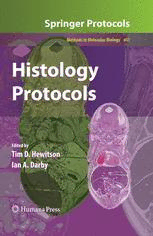
Histology Protocols PDF
Preview Histology Protocols
M M B TM ETHODS IN OLECULAR IOLOGY SeriesEditor JohnM.Walker SchoolofLifeSciences UniversityofHertfordshire Hatfield,Hertfordshire,AL109AB,UK Forothertitlespublishedinthisseries,goto www.springer.com/series/7651 Histology Protocols Edited by Tim D. Hewitson Royal Melbourne Hospital and University of Melbourne, Melbourne, VIC, Australia Ian A. Darby RMIT University, Bundoora, VIC, Australia Editors TimD.Hewitson IanA.Darby DepartmentofNephrology SchoolofMedicalSciences RoyalHospitalMelbourne Cancer&TissueRepairResearchGroup GrattanStreet,MelbourneVIC3050 RMITUniversity Australia PlentyRoad,MelbourneVIC3083 [email protected] Australia [email protected] ISSN1064-3745 e-ISSN1940-6029 ISBN978-1-60327-344-2 e-ISBN978-1-60327-345-9 DOI10.1007/978-1-60327-345-9 LibraryofCongressControlNumber:2009939928 #HumanaPress,apartofSpringerScienceþBusinessMedia,LLC2010 Allrightsreserved.Thisworkmaynotbetranslatedorcopiedinwholeorinpartwithoutthewrittenpermissionofthe publisher(HumanaPress,c/oSpringerScience+BusinessMedia,LLC,233SpringStreet,NewYork,NY10013,USA), exceptforbriefexcerptsinconnectionwithreviewsorscholarlyanalysis.Useinconnectionwithanyformofinformation storageandretrieval,electronicadaptation,computersoftware,orbysimilarordissimilarmethodologynowknownor hereafterdevelopedisforbidden. Theuseinthispublicationoftradenames,trademarks,servicemarks,andsimilarterms,eveniftheyarenotidentifiedas such,isnottobetakenasanexpressionofopinionastowhetherornottheyaresubjecttoproprietaryrights. Printedonacid-freepaper springer.com Preface Somuchofwhatweknowaboutthepathogenesisofhumandiseasehascomefromthe systematic and careful study of histological material. Indeed, every internal medicine discipline has its landmark papers describing the clinico-pathological correlations. However, increasingly, it is molecular and cellular biology that provides the necessary mechanistic insights. For many years, it was thought that the two skill sets were mutuallyexclusive,butwehopethatthisbookshowsthatthisisnotnecessarilyso. Implicitinthescienceofhistologyisthepreservationandarchivingoftissue.PartIof the bookconcentrates onthe preparationof tissue, providinganoverviewof fixation, embedding, and processing (Chapter 1), and in Chapters 2 and 3, the required techniques for the retrieval of RNA from histological sections. Both routine and specialisthistologicalstainingtechniquesareprovidedinPartII.Theseincludeproto- cols for immuno (Chapters 4–7), lectin (Chapter 8), and hybridization(Chapter9) histochemistry,histologicalstaining(Chapters10and11),aswellasspecificmethods for the in situ identification of hypoxia (Chapter 12) and apoptosis (Chapter 13). Finally, Part III details advances in imaging (Chapters 14–16) and image analysis (Chapter17). It is hoped that this volume will provide molecular biologists with the basic histo- chemical techniques and histologists with the molecular techniques to realise the potential of their resource. We are indebted to the authors for their generosity in sharingtheseprotocols. TimD.Hewitson IanA.Darby Melbourne,Australia October2009 v Contents Preface............................................................ v Contributors........................................................ ix PART I: TISSUE PROCESSING 1. TissuePreparationforHistochemistry:Fixation,Embedding,andAntigen RetrievalforLightMicroscopy........................................ 3 TimD.Hewitson,BelindaWigg,andGavinJ.Becker 2. AnOptimizedRNAExtractionMethodfromArchivalFormalin-Fixed Paraffin-EmbeddedTissue ........................................... 19 Joon-YongChungandStephenM.Hewitt 3. Laser-CaptureMicrodissectionandPressureCatapultingfortheAnalysis ofGeneExpressionintheRenalGlomerulus ............................. 29 AmandaJ.Edgley,RenaeM.Gow,andDarrenJ.Kelly PART II: STAINING TECHNIQUES 4. ImmunofluorescenceDetectionoftheCytoskeletonandExtracellularMatrix inTissueandCulturedCells.......................................... 43 JosianeSmith-ClercandBorisHinz 5. DoubleImmunohistochemistrywithHorseradishPeroxidaseandAlkaline PhosphataseDetectionSystems ....................................... 59 VincentSarrazyandAlexisDesmouli`ere 6. RetrogradelyTransportedNeuronalTracersCombinedwith ImmunohistochemistryUsingFree-FloatingBrainSections.................. 73 EmilioBadoer 7. High-PressureFreezing,ChemicalFixationandFreeze-Substitution forImmuno-electronMicroscopy...................................... 87 ChristianMu¨hlfeld 8. LectinHistochemistryforLightandElectronMicroscopy................... 103 SuEeWong,CatherineE.Winbanks,ChrishanS.Samuel, andTimD.Hewitson 9. DuplexInSituHybridizationintheStudyofGeneCo-regulation intheVertebrateBrain .............................................. 115 RaphaelPinaudandJinK.Jeong 10. SpecialStainsforExtracellularMatrix................................... 131 Andre´aMonte-Alto-CostaandLuı´sCristo´va˜oPorto 11. ActiveStainingofMouseEmbryosforMagneticResonanceMicroscopy........ 141 AlexandraPetietandG.AllanJohnson 12. ImmunohistochemicalDetectionofTumourHypoxia...................... 151 RichardJ.YoungandAndreasM¨oller vii viii Contents 13. InSituLocalizationofApoptosisUsingTUNEL.......................... 161 TimD.HewitsonandIanA.Darby PART III: IMAGING TECHNIQUES 14. UseofConfocalMicroscopyforThree-DimensionalImagingofNeurons intheSpinalCord.................................................. 173 MartinStebbing,SimonPotocnik,PingluYe,andEmilioBadoer 15. High-ResolutionConfocalImaginginTissue............................. 183 VerenaC.WimmerandAndreasM¨oller 16. Software-BasedStackingTechniquestoEnhanceDepthofFieldandDynamic RangeinDigitalPhotomicrography.................................... 193 Jo¨rgPiper 17. ImageAnalysisandQuantitativeMorphology ............................ 211 CarlosAlbertoMandarim-de-Lacerda,CarolineFernandes-Santos, andMarciaBarbosaAguila SubjectIndex .......................................................... 227 Contributors MARCIABARBOSAAGUILA (cid:129) LaboratoryofMorphometryandCardiovascularMorphology, Institute of Biology, Biomedical Center, State University of Rio de Janeiro, Rio de Janeiro,Brazil EMILIO BADOER (cid:129) School of Medical Sciences, RMIT University, Melbourne, VIC, Australia GAVIN J. BECKER (cid:129) Department of Nephrology, The Royal Melbourne Hospital, and DepartmentofMedicine,UniversityofMelbourne,Melbourne,VIC,Australia JOON-YONGCHUNG (cid:129) TissueArrayResearchProgram,LaboratoryofPathology,Center for Cancer Research, National Cancer Institute; National Institutes of Health, Bethesda,MD,USA LUI´SCRISTO´VA˜ODEMORAESSOBRINOPORTO (cid:129) TissueRepairLaboratory,Histologyand EmbryologyDepartment,StateUniversityofRiodeJaneiro,RiodeJaneiro,Brazil IAN A. DARBY (cid:129) Cancer and Tissue Repair Research Group, School of Medical Sciences, RMITUniversity,Melbourne,VIC,Australia ALEXIS DESMOULIE`RE (cid:129) Department of Physiology, and EA 3842, Institut Fe´de´ratif de Recherche145,Faculte´ deMe´decineetdePharmacie,Universite´ deLimoges,Limoges, France AMANDA J. EDGLEY (cid:129) Department of Medicine, St. Vincent’s Hospital, University of Melbourne,Melbourne,VIC,Australia CAROLINE FERNANDES-SANTOS (cid:129) Laboratory of Morphometry and Cardiovascular Mor- phology,InstituteofBiology,BiomedicalCenter,StateUniversityofRiodeJaneiro,Rio deJaneiro,Brazil RENAE M. GOW (cid:129) Department of Medicine, St Vincent’s Hospital, University of Mel- bourne,Fitzroy,Melbourne,VIC,Australia TIM D. HEWITSON (cid:129) Department of Nephrology, The Royal Melbourne Hospital; and DepartmentofMedicine,UniversityofMelbourne,Melbourne,VIC,Australia STEPHENM.HEWITT (cid:129) TissueArrayResearchProgram,LaboratoryofPathology,Center for Cancer Research, National Cancer Institute, National Institutes of Health, Bethesda,MD,USA BORIS HINZ (cid:129) CIHR Group in Matrix Dynamics, Laboratory of Tissue Repair and Regeneration, Faculty of Dentistry, University of Toronto, Toronto, ON, Canada; andLaboratoryofCellBiophysics,EcolePolytechniqueFe´de´raledeLausanne(EPFL), Lausanne,Switzerland JIN K. JEONG (cid:129) Department of Brain and Cognitive Sciences, University of Rochester, Rochester,NY,USA G.ALLANJOHNSON (cid:129) CenterforInVivoMicroscopy,DukeUniversity,Durham,NC,USA DARREN J. KELLY (cid:129) Department of Medicine, St. Vincent’s Hospital, University of Mel- bourne,Melbourne,VIC,Australia ix x Contributors CARLOSALBERTOMANDARIM-DE-LACERDA (cid:129) LaboratoryofMorphometryandCardiovas- cular Morphology, Institute of Biology, Biomedical Center, State University of Rio de Janeiro,RiodeJaneiro,Brazil ANDREASMo¨LLER (cid:129) ResearchDivision,CancerGenomicsandBiochemistryLaboratory, PeterMacCallumCancerCentre,Melbourne,VIC,Australia ANDRE´A MONTE-ALTO-COSTA (cid:129) Tissue Repair Laboratory, Histology and Embryology Department,StateUniversityofRiodeJaneiro,RiodeJaneiro,Brazil CHRISTIANMU¨HLFELD (cid:129) InstituteofAnatomyandCellBiology,Justus-Liebig-University Giessen,Giessen,Germany ALEXANDRAPETIET (cid:129) Neurospin,CEASaclay,Gif-sur-Yvette,France RAPHAEL PINAUD (cid:129) Department of Brain and Cognitive Sciences; Center for Visual Science and Center for Navigation and Communication Sciences, University of Rochester,Rochester,NY,USA Jo¨RGPIPER (cid:129) ClinicMeduna,BadBertrich,D-56864BadBertrich,Germany SIMON POTOCNIK (cid:129) School of Medical Sciences, RMIT University, Melbourne, VIC, Australia CHRISHAN S. SAMUEL (cid:129) Howard Florey Institute, The University of Melbourne, Mel- bourne,VIC,Australia VINCENTSARRAZY (cid:129) Faculte´deMe´decineetdePharmacie,EA3842,InstitutFe´de´ratifde Recherche145,Universite´ deLimoges,Limoges,France JOSIANE SMITH-CLERC (cid:129) Laboratory of Cell Biophysics, Ecole Polytechnique Fe´de´rale de Lausanne(EPFL),Lausanne,Switzerland MARTIN STEBBING (cid:129) School of Medical Sciences, RMIT University, Melbourne, VIC, Australia BELINDAWIGG (cid:129) DepartmentofNephrology,TheRoyalMelbourneHospital,Melbourne, VIC,Australia VERENA C. WIMMER (cid:129) Ion Channels and Disease Group, Howard Florey Institute, The UniversityofMelbourne,Melbourne,VIC,Australia CATHERINE WINBANKS (cid:129) Baker IDI Heart and Diabetes Institute, Melbourne, VIC, Australia SU EE WONG (cid:129) Department of Nephrology, The Royal Melbourne Hospital, Melbourne, VIC,Australia PINGLUYE (cid:129) SchoolofMedicalSciences,RMITUniversity,Melbourne,VIC,Australia RICHARD J. YOUNG (cid:129) Research Division, Translational Research Laboratory, Peter MacCallumCancerCentre,Melbourne,VIC,Australia Part I Tissue Processing Chapter 1 Tissue Preparation for Histochemistry: Fixation, Embedding, and Antigen Retrieval for Light Microscopy Tim D. Hewitson, Belinda Wigg, and Gavin J. Becker Abstract A number of techniques have been developed to use chemical, immunological, and molecular biology assays in histological material. Collectively termed histochemistry, these techniques have allowed us to betterunderstandtissueandorganbiologyinsitu.Successwitheachofthesemethodsisdependentonthe adequatepreparationofmaterial.Inthisarticle,wedescribethebasicstepsrequiredtopreparetissuefor routinehistochemicalanalysis. Histochemicaltechniquesroutinelyusefrozenandparaffin-embeddedtissueasabasisforcellularand morphological analysis. Freezing tissue results in less alteration to epitopes and therefore may offer improvedstainingcharacteristicscomparedtotechniquesbasedonparaffinembedding.Asinconventional histology,theuseoffixationandembeddinginmorerigidmediasuchaswaxoffersanumberofpotential advantagesrelatedtoimprovedstructuraldetail.Improvementsinmorphologymayhoweverbeoffsetbya lossofantigens.Thecarefulapplicationofantigenretrievaltechniquesmayovercomethesedeficiencies. Keywords:Histochemistry,fixative,histology,antigenretrieval. 1. Introduction For more than three decades, a variety of techniques have been developedtousechemical,immunological,andmolecularbiology assaysinhistologicalmaterial.Collectivelytermedhistochemistry, these techniques have allowed us to better understand tissue and organbiologyinsitu. In its simplest form, histochemistry uses sections of unfixed frozen tissue to maximize the accessibility of antigens, proteins, and genetic material. However, as in conventional histology, the use of fixation and embedding in more rigid media, such as wax, offersanumberofpotentialadvantagesrelatedtoimprovedmor- phology(1,2). T.D.Hewitson,I.A.Darby(eds.),HistologyProtocols,MethodsinMolecularBiology611, DOI10.1007/978-1-60327-345-9_1,ªHumanaPress,apartofSpringerScience+BusinessMedia,LLC2010 3
